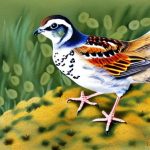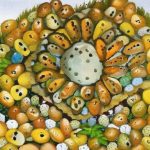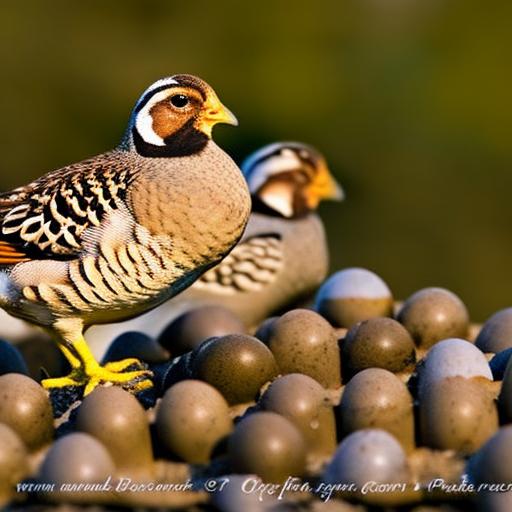Quail breeding is a popular practice among farmers and hobbyists alike. Understanding the basics of quail breeding is essential for successful and sustainable breeding practices. Quails are small game birds that are known for their fast growth and high egg production. They are relatively easy to breed and require minimal space, making them an ideal choice for those with limited resources. Quails reach sexual maturity at around 6-8 weeks of age, and they can lay up to 300 eggs per year. When breeding quails, it is important to consider factors such as genetics, nutrition, and environmental conditions to ensure the health and productivity of the birds. Additionally, understanding the behavior and social dynamics of quails is crucial for successful breeding, as they are known to be social birds that thrive in groups.
Quail breeding pens should be designed to provide a comfortable and stress-free environment for the birds. It is important to consider factors such as space, ventilation, lighting, and temperature control when setting up a quail breeding pen. Additionally, proper feeding and watering systems should be in place to ensure the nutritional needs of the birds are met. Monitoring and managing the breeding pen is also essential to ensure the health and productivity of the quails. Overall, understanding the intricacies of quail breeding is crucial for successful and sustainable breeding practices.
Table of Contents
- 1 Selecting the Right Breeding Pen
- 2 Building a Quail Breeding Pen
- 3 Maintaining the Quail Breeding Pen
- 4 Ensuring Proper Ventilation and Lighting
- 5 Feeding and Watering Systems for Quail Breeding Pens
- 6 Monitoring and Managing Quail Breeding Pens
- 7 FAQs
- 7.1 What are quail breeding pen plans?
- 7.2 Why are quail breeding pen plans important?
- 7.3 What should be considered when choosing quail breeding pen plans?
- 7.4 Where can I find quail breeding pen plans?
- 7.5 Are there different types of quail breeding pen plans?
- 7.6 What are some key features of quail breeding pen plans?
Key Takeaways
- Quail breeding requires understanding of their natural mating behaviors and reproductive cycles
- The right breeding pen should provide enough space and privacy for quails to mate and lay eggs
- Building a quail breeding pen involves using materials that are safe, durable, and easy to clean
- Regular cleaning, disinfecting, and monitoring of the breeding pen is essential for maintaining a healthy environment for quails
- Proper ventilation and lighting are crucial for regulating temperature, humidity, and the natural breeding cycle of quails
- Feeding and watering systems should be designed to provide easy access to food and clean water for the quails
- Regular monitoring of quail health, egg production, and breeding behavior is necessary for successful quail breeding management
Selecting the Right Breeding Pen
Selecting the right breeding pen is crucial for successful quail breeding. When choosing a breeding pen, it is important to consider factors such as size, material, and design. The size of the breeding pen will depend on the number of quails being bred, as well as the available space. It is important to provide enough space for the birds to move around comfortably and engage in natural behaviors such as dust bathing and foraging. The material of the breeding pen should be durable and easy to clean, as cleanliness is essential for the health of the birds. Additionally, the design of the breeding pen should allow for easy access to the birds for monitoring and management purposes.
Another important factor to consider when selecting a breeding pen is ventilation. Proper ventilation is essential for maintaining good air quality and preventing the buildup of harmful gases such as ammonia. The pen should be designed to allow for adequate airflow while protecting the birds from drafts and extreme temperatures. Lighting is also an important consideration when selecting a breeding pen, as it can affect the behavior and productivity of the birds. Overall, selecting the right breeding pen is essential for creating a comfortable and stress-free environment for the quails to thrive and reproduce.
Building a Quail Breeding Pen
Building a quail breeding pen requires careful planning and attention to detail. The first step in building a breeding pen is to determine the size and layout of the pen based on the number of quails being bred and the available space. The pen should be spacious enough to accommodate the birds comfortably while allowing for natural behaviors such as dust bathing and foraging. The material used to build the pen should be durable, easy to clean, and predator-proof to ensure the safety and security of the birds.
Proper ventilation is essential when building a quail breeding pen. The pen should be designed to allow for adequate airflow while protecting the birds from drafts and extreme temperatures. Additionally, lighting should be considered when building the pen, as it can affect the behavior and productivity of the birds. It is important to provide natural light as well as artificial lighting to ensure proper day-night cycles for the birds. Finally, proper feeding and watering systems should be incorporated into the design of the pen to ensure the nutritional needs of the birds are met. Overall, building a quail breeding pen requires careful consideration of factors such as size, material, ventilation, lighting, and feeding and watering systems to create a comfortable and stress-free environment for the birds.
Maintaining the Quail Breeding Pen
Maintaining a quail breeding pen is essential for ensuring the health and productivity of the birds. Regular cleaning and sanitation are crucial for preventing the buildup of harmful bacteria and parasites that can affect the health of the birds. The pen should be cleaned on a regular basis, with soiled bedding removed and replaced with fresh bedding to maintain good hygiene. Additionally, regular inspections should be conducted to check for any signs of illness or injury in the birds.
Proper maintenance of the breeding pen also includes monitoring environmental conditions such as temperature and humidity. The pen should be equipped with temperature control measures such as heaters or fans to ensure that the birds are kept at a comfortable temperature at all times. Additionally, proper ventilation should be maintained to prevent the buildup of harmful gases such as ammonia. It is also important to regularly check for any signs of wear and tear in the pen and make any necessary repairs or replacements to ensure the safety and security of the birds. Overall, maintaining a quail breeding pen requires regular cleaning, sanitation, monitoring of environmental conditions, and prompt repairs to ensure the health and well-being of the birds.
Ensuring Proper Ventilation and Lighting
Proper ventilation and lighting are essential components of a successful quail breeding pen. Adequate ventilation is crucial for maintaining good air quality and preventing the buildup of harmful gases such as ammonia. The pen should be designed to allow for adequate airflow while protecting the birds from drafts and extreme temperatures. Natural ventilation can be achieved through windows or vents, while artificial ventilation can be provided through fans or exhaust systems.
In addition to ventilation, proper lighting is also important for quail breeding pens. Lighting can affect the behavior and productivity of the birds, so it is important to provide natural light as well as artificial lighting to ensure proper day-night cycles for the birds. Natural light can be provided through windows or skylights, while artificial lighting can be provided through overhead lights or lamps. It is important to ensure that there is a balance between natural and artificial lighting to create a comfortable environment for the birds.
Overall, ensuring proper ventilation and lighting in a quail breeding pen is essential for creating a comfortable and stress-free environment for the birds to thrive and reproduce.
Feeding and Watering Systems for Quail Breeding Pens

Feeding and watering systems are essential components of a successful quail breeding pen. Proper nutrition is crucial for ensuring the health and productivity of the birds, so it is important to provide a balanced diet that meets their nutritional needs. Quails require a diet that is high in protein, so it is important to provide them with a commercial game bird feed that contains at least 20% protein. Additionally, it is important to provide access to grit or small stones to help with digestion.
In addition to proper nutrition, access to clean water is also essential for quails. Watering systems should be designed to provide a constant supply of clean water for the birds at all times. This can be achieved through automatic waterers or water dispensers that are regularly checked and refilled as needed. It is important to ensure that waterers are kept clean and free from contaminants to prevent illness in the birds.
Overall, feeding and watering systems for quail breeding pens should be designed to provide a balanced diet and constant access to clean water to ensure the health and productivity of the birds.
Monitoring and Managing Quail Breeding Pens
Monitoring and managing a quail breeding pen is essential for ensuring the health and productivity of the birds. Regular monitoring should be conducted to check for any signs of illness or injury in the birds. This can include observing their behavior, checking their droppings, and inspecting their feathers for any signs of parasites or disease.
In addition to monitoring individual birds, it is also important to monitor environmental conditions within the pen. This can include checking temperature and humidity levels, as well as ensuring proper ventilation and lighting. Any issues with environmental conditions should be promptly addressed to ensure that the birds are kept in a comfortable and stress-free environment.
Overall, monitoring and managing a quail breeding pen requires regular inspections of both individual birds and environmental conditions to ensure their health and well-being. By staying vigilant and proactive in monitoring and managing their breeding pens, breeders can ensure that their quails remain healthy, productive, and happy.
If you’re interested in quail breeding pen plans, you may also want to learn about how many eggs geese lay. Check out this article to find out more about geese breeding and egg production.
FAQs
What are quail breeding pen plans?
Quail breeding pen plans are detailed instructions and designs for constructing a pen or enclosure specifically designed for breeding and raising quail.
Why are quail breeding pen plans important?
Quail breeding pen plans are important because they provide a structured and efficient way to create a suitable environment for quail breeding. They ensure that the pens are designed to meet the specific needs of quail, including space, ventilation, and security.
What should be considered when choosing quail breeding pen plans?
When choosing quail breeding pen plans, it is important to consider factors such as the number of quail to be housed, available space, climate, and the materials and tools needed for construction.
Where can I find quail breeding pen plans?
Quail breeding pen plans can be found online through various websites, forums, and agricultural publications. Additionally, some local agricultural extension offices or quail breeding associations may offer resources or guidance on obtaining quail breeding pen plans.
Are there different types of quail breeding pen plans?
Yes, there are different types of quail breeding pen plans, including plans for individual breeding pens, colony breeding pens, and larger scale commercial breeding facilities. The type of plan needed will depend on the specific goals and scale of the quail breeding operation.
What are some key features of quail breeding pen plans?
Key features of quail breeding pen plans may include proper ventilation, adequate space for nesting and roosting, secure fencing to prevent predators, and easy access for feeding and egg collection. The plans should also take into account the specific needs of the quail species being bred.
Meet Walter, the feathered-friend fanatic of Florida! Nestled in the sunshine state, Walter struts through life with his feathered companions, clucking his way to happiness. With a coop that’s fancier than a five-star hotel, he’s the Don Juan of the chicken world. When he’s not teaching his hens to do the cha-cha, you’ll find him in a heated debate with his prized rooster, Sir Clucks-a-Lot. Walter’s poultry passion is no yolk; he’s the sunny-side-up guy you never knew you needed in your flock of friends!







